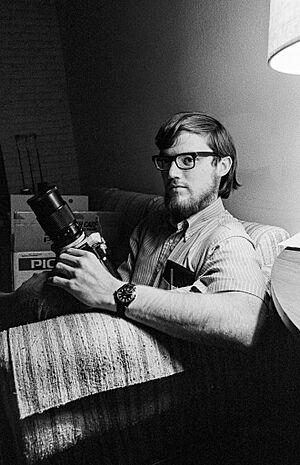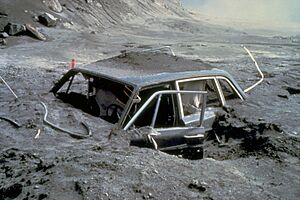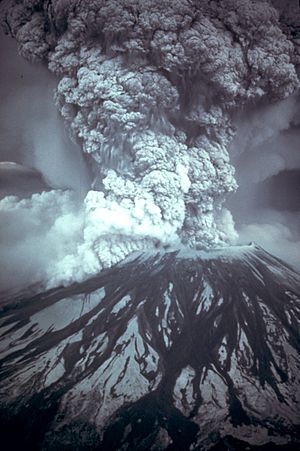Reid Blackburn facts for kids
Quick facts for kids
Reid Blackburn
|
|
|---|---|

Reid Blackburn, picture taken 1970–1971.
|
|
| Born |
Reid Turner Blackburn
August 11, 1952 |
| Died | May 18, 1980 (aged 27) near Mount St. Helens, Washington, U.S. 46°17′53.1″N 122°17′23.5″W / 46.298083°N 122.289861°W
|
| Cause of death | Killed by a pyroclastic flow caused by the 1980 eruption of Mount St. Helens |
| Nationality | American |
| Occupation | Photographer |
Reid Turner Blackburn (born August 11, 1952 – died May 18, 1980) was an American photographer. He sadly passed away during the big 1980 eruption of Mount St. Helens.
Reid was a photojournalist, which means he took pictures for news stories. He was covering the volcano for a local newspaper called The Columbian, and also for National Geographic magazine and the United States Geological Survey (USGS). He was at a place called Coldwater Camp when the eruption happened.
His car and body were found four days later. About a week after that, his camera was found buried under all the ash and rock from the eruption.
After he passed away, his friends and coworkers said many kind things about him. They talked about how talented and excited he was about his work. His wife, Fay, felt that he died doing what he truly loved.
Contents
Reid Blackburn's Early Life
Reid Blackburn was born in 1952. His dad was an engineer who loved to figure out how things worked.
Reid loved photography, saying it was like "painting with light". He was a very good photographer and even won awards for his pictures. He also wrote a book about hydroplane racing, which is a type of boat racing.
Reid went to Linfield College in Oregon. In 1975, he started working at The Columbian newspaper as a photojournalist. There, he met Fay Mall, who worked in the advertising department. They dated for several months and got married in the summer of 1979. Reid enjoyed hiking and loved being outdoors.
Documenting Mount St. Helens
Reid's coworker and photo editor, Steve Small, said that Mount St. Helens was Reid's favorite mountain. They climbed it together many times and called it "the Sleeping Beauty of the Northwest."
Reid became very interested in Mount St. Helens in March 1980. This was when a series of earthquakes started shaking the volcano. Since he had already climbed the mountain, he was curious about what was happening. He was chosen to take pictures of the volcano's activity because he was good at outdoor skills and very careful.
By May, he was camping near the volcano. He was taking pictures for The Columbian, National Geographic, and the United States Geological Survey.
Reid was supposed to leave the mountain by May 17, but he decided to stay a few more days. On the day of the eruption, he was near Coldwater Creek, about 8 miles (13 km) from the volcano.
Early on May 18, a 5.1 Richter scale earthquake hit the area. This caused a huge volcanic landslide, where about 0.6 cubic miles (2.5 cubic km) of rock slid down. This released pressure on the volcano's crater, causing steam to burst out. Just seconds later, Mount St. Helens erupted sideways. It sent very fast flows of hot gas and rock, called pyroclastic flows, into the forest below.
During the eruption, Reid was able to trigger two special Nikon cameras. These cameras were set up on tripods at his Coldwater I camp and another spot above Spirit Lake. They were powered by a car battery and kept safe in Styrofoam ice chests. His last notes showed he took pictures at 8:33 AM and 8:34 AM. His notebook was found inside his radio case. Sadly, neither of the remote cameras were ever found.
Reid Blackburn's Death
Reid Blackburn died when a pyroclastic flow covered the area where he was camped. His car was found four days later. It was buried up to the windows in ash, with his body inside. The car windows were broken, and ash filled the inside.
In early June, another National Geographic photographer, Fred Stocker, found Reid's camera. It was buried under about 2.5 feet (0.76 m) of ash. The film inside could not be saved because the extreme heat from the eruption had ruined it.
The 1980 eruption of Mount St. Helens was the deadliest and most destructive volcanic eruption in U.S. history. A total of 57 people died. Many more lost their homes when ash and pyroclastic flows destroyed or buried 200 houses. Besides Reid Blackburn, other people who died included local resident Harry R. Truman, photographer Robert Landsburg, and volcanologist David A. Johnston.
Remembering Reid Blackburn
After Reid's death, his friends and coworkers shared many kind words about him. They described him as having a playful and mischievous side that his friends loved. Coworker Mike Prager called Reid "one of the funniest and most talented journalists" in the Pacific Northwest. He said Reid made his job look easy because he was so good at it.
Tom Koenninger, the editor of The Columbian, said Reid's humor was "wry" and sometimes "acerbic" (meaning a bit sharp or critical). But he also said Reid was "gentle" and only showed aggression when he needed to get close to something he was photographing.
Reid's wife, Fay Blackburn, spoke about his dedication to photography. She said, "if Reid were alive today, he'd probably be back on the front line seeking to capture the latest chapter in the mountain's evolution, in spite of the risk." She added, "Reid loved that mountain. He climbed it, hiked it, skied it." Fay felt that he died doing what he loved.
The National Press Photographers Association gives a special scholarship each year in Reid's honor. It is worth $2,000. In 2005, The Columbian newspaper also offered an internship for scholarship applicants to remember Reid.
In December 2013, a roll of undeveloped film was found in Reid Blackburn's old files at The Columbian. The film contained pictures of Mount St. Helens taken by Reid from a helicopter the month before the eruption. These photos were successfully developed over 30 years after Reid's death. They are still important today as a record of what the mountain looked like before the eruption.



